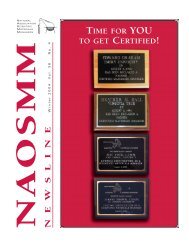Laboratory Safety Guidance
OSHA Lab Safety Guidance - ORS Optical Remote Sensing ...
OSHA Lab Safety Guidance - ORS Optical Remote Sensing ...
- No tags were found...
Create successful ePaper yourself
Turn your PDF publications into a flip-book with our unique Google optimized e-Paper software.
• Brochures/Booklets<br />
■ Principal Emergency Response and Preparedness – Requirements and <strong>Guidance</strong>. OSHA Publication<br />
3122 (2004) http://www.osha.gov/Publications/osha3122.pdf<br />
■ How to Plan for Workplace Emergencies and Evacuations. OSHA Publication 3088 (2001).<br />
http://www.osha.gov/Publications/osha3088.pdf<br />
• QuickFact<br />
■ <strong>Laboratory</strong> <strong>Safety</strong> – Working with Small Animals. OSHA Publication 3412 (2011).<br />
http://www.osha.gov/Publications/3412-quickfact.pdf<br />
• eTool<br />
■ Evacuation Plans and Procedures<br />
http://www.osha.gov/SLTC/etools/evacuation/index.html<br />
• eTool<br />
■ Emergency Preparedness and Response<br />
http://www.osha.gov/SLTC/emergencypreparedness/index.html<br />
Exit Routes standards (29 CFR 1910.34 – 29 CFR 1910.37). All employers must comply with OSHA’s<br />
requirements for exit routes in the workplace.<br />
• Complete standards<br />
■ 29 CFR 1910.34<br />
http://www.osha.gov/pls/oshaweb/owadisp.show_document?p_table=STANDARDS&p_id=12886<br />
■ 29 CFR 1910.35<br />
http://www.osha.gov/pls/oshaweb/owadisp.show_document?p_table=STANDARDS&p_id=9723<br />
■ 29 CFR 1910.36<br />
http://www.osha.gov/pls/oshaweb/owadisp.show_document?p_table=STANDARDS&p_id=9724<br />
■ 29 CFR 1910.37<br />
http://www.osha.gov/pls/oshaweb/owadisp.show_document?p_table=STANDARDS&p_id=9725<br />
• Fact Sheet<br />
■ Emergency Exit Routes. http://www.osha.gov/OshDoc/data_General_Facts/emergency-exit-routesfactsheet.pdf<br />
• QuickCard<br />
■ Emergency Exit Routes. OSHA Publication 3183 (2003).<br />
Medical and First Aid standard (29 CFR 1910.151). OSHA requires employers to provide medical and<br />
first-aid personnel and supplies commensurate with the hazards of the workplace. The details of a workplace<br />
medical and first-aid program are dependent on the circumstances of each workplace and employer.<br />
• Complete standard<br />
■ 29 CFR 1910.151<br />
http://www.osha.gov/pls/oshaweb/owadisp.show_document?p_table=STANDARDS&p_id=9806<br />
• Brochures/Booklets<br />
■ Best Practices Guide: Fundamentals of a Workplace First-Aid Program. OSHA Publication 3317 (2006)<br />
http://www.osha.gov/Publications/OSHA3317first-aid.pdf<br />
• <strong>Safety</strong> and Health Topics Page<br />
■ Medical and First Aid<br />
http://www.osha.gov/SLTC/medicalfirstaid/index.html<br />
Recordkeeping standard (29 CFR 1904). OSHA requires most employers to keep records of workplace<br />
injuries and illnesses. The employer should first determine if it is exempt from the routine recordkeeping<br />
requirements. An employer is not required to keep OSHA injury and illness records (unless asked to do so<br />
in writing by OSHA or the Bureau of Labor Statistics) if:<br />
• It had 10 or fewer workers during all of the last calendar year (29 CFR 1904.1); or<br />
• It is engaged in certain low-hazard industries (29 CFR Part 1904, Subpart B, Appendix A). The following<br />
types of healthcare facilities are exempt from OSHA’s injury and illness recordkeeping requirements,<br />
regardless of size:<br />
■ Offices and Clinics of Medical Doctors (SIC 801)<br />
■ Offices and Clinics of Dentists (SIC 802)<br />
■ Offices of Osteopathic Physicians (SIC 803)<br />
3 8<br />
Occupational <strong>Safety</strong> and<br />
Health Administration



